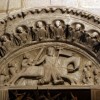- Accede I
- Regístrate I
- carrito
Representaciones del Apóstol
La Plaza del Obradoiro es un excelente resumen visual de las posibles representaciones iconográficas que se han hecho de Santiago. En la fachada de la Catedral es el peregrino de esclavina, sombrero y bordón. En el Hostal de los Reyes Católicos y en el Colegio de San Xerome aparece como apóstol, aunque con guiños a los símbolos peregrinos. Y finalmente en lo alto del Palacio de Rajoy está representado como guerrero, a lomos de su caballo blanco y junto a la famosa Batalla de Clavijo.
Alfonso Rodríguez Castelao lo explica en su libro, ‘Sempre en Galiza’: "Europa representó al Apóstol Santiago a semejanza de sus peregrinos, con esclavina y sombrero cubiertos de conchas-vieras (...) tal como se ve en la cumbre de Saint Jaques de París, a modo de santo protector de los caminos, símbolo del alma viajera de Europa".
"España representó al Apóstol Santiago a semejanza de los guerreros de la Reconquista, montado en un caballo blanco y blandiendo una espada (...); este es el Santiago Matamoros que se venera en las iglesias hispanas a modo de patrón provincial o patrón de las Españas".
"Galicia representó al Apóstol Santiago a semejanza de los Patriarcas, sentado en majestad, (...) los ojos enfilados hacia el ignoto Occidente y labios que repiten aquel salmo de David: ‘en el mar están tus caminos y en las muchas aguas tus sendas’. Así lo representó el maestro Mateo y así lo esculpió en el Pórtico de la Gloria, con réplica en el altar mayor para recibir a los antiguos visitantes de su Catedral".



















